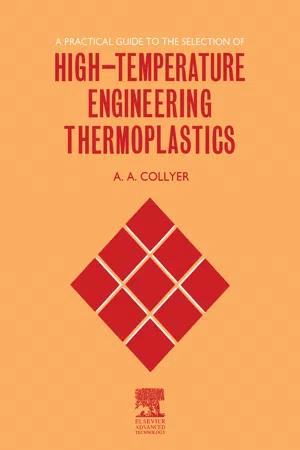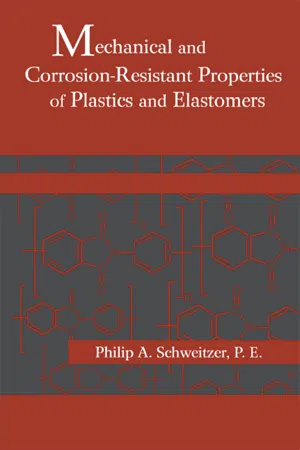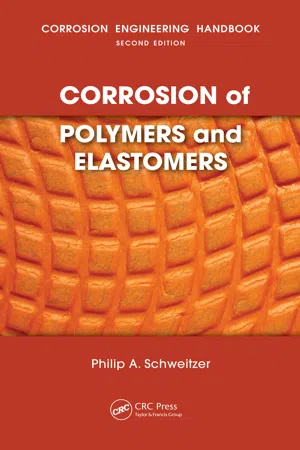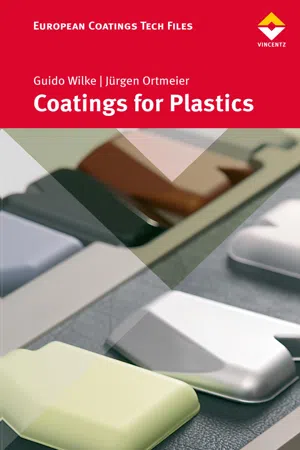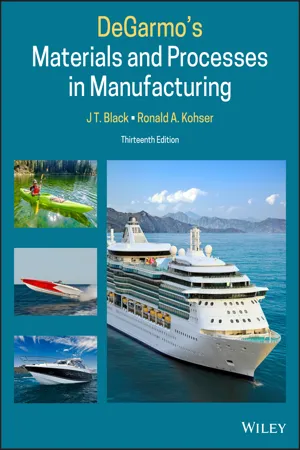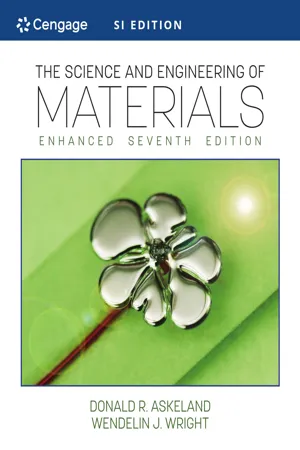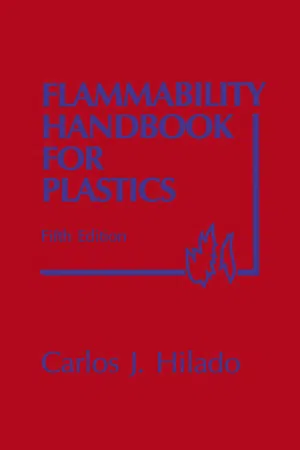Technology & Engineering
Thermoplastic
Thermoplastics are a type of polymer that can be melted and reshaped multiple times without undergoing significant chemical change. They are widely used in manufacturing due to their versatility, recyclability, and ability to be molded into various shapes. Common thermoplastics include polyethylene, polypropylene, and polystyrene.
Written by Perlego with AI-assistance
Related key terms
1 of 5
10 Key excerpts on "Thermoplastic"
- A.A. Collyer(Author)
- 2016(Publication Date)
- Elsevier Science(Publisher)
Thermoplastics as Engineering Materials Chapter 1 Thermoplastics as engineering materials Do you know what happened to the man who didn't know the difference between vaseline and putty? All his windows feU out. What bad materials selection! 1.1 Introduction The definition of high temperature engineering Thermoplastics is difficult and is inevitably a matter of opinion. A definition by McQuiston [1J of engineering plastics may be of some assistance: 'Engineering plastics are those high-performance plastics that provide multiple engineering properties at an economically feasible cost, can be processed without unusual measures; and are consumed at a rate of more than one million pounds (450 000 kg) per year'. In 1980, when this paper was published, the following Thermoplastics fitted into this category: • nylon (polyamide) family (PA), • polycarbonate (PC), • modified polyphenyleneoxide (PPO), • polyacetal and copolymers (PAC), • engineering acrylonitrile-butadiene-styrene (ABS), • Thermoplastic polyesters (polybutylene-terephthalate, PBT, and poly-ethyleneterephthalate, PET), • polysulphone (PSO) and • potyphenylenesulphide (PPS). The main problem lies in differentiating between the engineering Thermoplastics and the speciality Thermoplastics, which according to the above definition would include: • polyethersulphone (PES), • polyphenylsulphone (PPSO), • polyamideimide (PAI), • polyaiylate (PAR) and • fluoropolymers. In addition to these there are new commercial Thermoplastics: • polyetherimide (PEI), • polyetheretherketone (PEEK) and • liquid crystal polymers (LCP). McQuiston was very much aware of the problems of defining engineering plastics and of differentiating between them and speciality Thermoplastics. In the present work no distinction will be made. Consideration will be restricted to those Thermoplastics that can be used in load-bearing applications at 1- Philip A. Schweitzer(Author)
- 2000(Publication Date)
- CRC Press(Publisher)
2 Thermoplastic Polymers 2.1 INTRODUCTION TO Thermoplastic POLYMERS As discussed previously, Thermoplastic polymers can be repeatedly re-formed by the application of heat, similar to metallic materials. They are long-chain linear molecules that are easily formed by the application of heat and pressure at temperatures above a critical temperature referred to as the “glass temperature.” Because of this ability to be re-formed by heat, these materials can be recycled. However, thermal aging which results from repeated exposure to the high temperatures required for melting, causes eventual degradation of the polymer and limits the number of reheat cycles. Polymers are formed as the result of a polymerization reaction of a monomer which is a single molecule or substance consisting of single molecules. Copolymers are long-chain molecules formed by the addition reaction of two or more monomers. In essence, they are chains in which one mer has been substituted with another mer. When the chain of a polymer is made up of a single repeating section, it is referred to as a homopolymer in contrast to a copolymer. Thermoplastic polymers can be either homopolymers or copolymers. Alloy polymers are blends of different polymers. In general, Thermoplastic materials tend to be tougher and less brittle than thermoset polymers so they can be used without the need for incorporating fillers. However, all thermoplasts do not fall into this category. Some tend to craze or crack easily, so each case must be considered on its individual merits. By virtue of their basic polymer structure, Thermoplastics have been less dimensionally and thermally stable than thermosetting polymers. Therefore, thermosets have offered a performance advantage, although the lower processing costs for Thermoplastics 29 30 Chapter 2 have given the latter a cost advantage. Because of three major developments, thermosets and Thermoplastics are now considered on the basis of performance.- eBook - PDF
Fundamentals of Modern Manufacturing
Materials, Processes, and Systems
- Mikell P. Groover(Author)
- 2016(Publication Date)
- Wiley(Publisher)
The word is derived from the Greek words poly, meaning “many,” and meros (reduced to mer), meaning “part.” Most polymers are based on carbon and are therefore organic chemicals. As engineering materials, polymers are relatively new compared to metals and ceramics (see Historical Note 8.1 at www.wiley.com/college/groover). Polymers can be classified into three types: (1) Thermoplastic polymers, (2) thermosetting polymers, and (3) elastomers. Thermoplastic polymers (TP), also called Thermoplastics, are solid materials at room temperature, but they become viscous liquids when heated to temperatures of only a few hundred degrees. This characteristic allows them to be easily and economically shaped into products. They can be subjected to this heating and cooling cycle repeat- edly without significant degradation. Thermosetting polymers (TS), or thermosets, cannot tolerate repeated heating cycles as Thermoplastics can; when initially heated, they soften and flow for mold- ing, but the elevated temperatures also produce a chemical reaction that hardens the material into an infusible solid. If reheated, thermosetting polymers degrade and char rather than soften. Elastomers (E) are polymers that exhibit extreme elastic extensibility when subjected to relatively low mechan- ical stress. Some elastomers can be stretched by a factor of 10 and yet completely recover to their original shape. Although their properties are quite different from thermosets, they have a similar molecular structure that is different from the Thermoplastics. In popular nomenclature, thermoplas- tics and thermosets are known as plastics and elastomers are known as rubbers. Thermoplastics are commercially the most important of the three types, constituting around 70% of the tonnage of all synthetic polymers produced. Thermosets and elastomers share the remaining 30% about evenly. Common TP polymers include polyethylene, polyvinylchloride, polypropylene, polystyrene, and nylon. - eBook - PDF
- P.E., Philip A. Schweitzer(Authors)
- 2006(Publication Date)
- CRC Press(Publisher)
2 Thermoplastic Polymers Thermoplastic materials can be repeatedly re-formed by the application of heat, similar to metallic materials. They are long-chain linear molecules that are easily formed by the application of heat and pressure at temperatures above a critical temperature referred to as the glass temperature . Because of this ability to be re-formed by heat, these materials can be recycled. However, thermal aging that results from repeated exposure to the high temperatures required for melting causes eventual degradation of the polymer and limits the number of reheat cycles. Polymers are formed as the result of a polymerization reaction of a monomer that is a single molecule or substance consisting of single molecules. Copolymers are long-chain molecules formed by the addition reaction of two or more monomers. In essence, they are chains where one mer has been substituted with another mer. When the chain of a polymer is made up of a single repeating section, it is referred to as a homopolymer in contrast to a copolymer. Thermoplastic polymers can be either homopolymers or copolymers. Alloy polymers are blends of different polymers. In general, Thermoplastic materials tend to be tougher and less brittle than thermoset polymers, so they can be used without the need for incorporating fillers. However, all thermoplasts do not fall into this category. Some tend to craze or crack easily, so each case must be considered on its individual merits. By virtue of their basic structure, Thermoplastics have been less dimensionally and thermally stable than thermosetting polymers. Therefore, thermosets have offered a performance advantage; although, the lower processing costs for Thermoplastics have given the latter a cost advantage. Because of three major developments, thermosets and Thermoplastics are now considered on the basis of their performance. First, stability of Thermoplastics has been greatly improved by the use of fiber reinforcement. - eBook - PDF
- J Maxwell(Author)
- 1994(Publication Date)
- Woodhead Publishing(Publisher)
Understanding plastics Classifying plastics The term ‘plastics’ covers a broader variety of species than the term ‘metals’. Hence, without effective classification, the possibilities for over- simplification and confusion are endless. In terms of mechanical performance in automotive applications, and in particular the response to stress, probably the most important distinction is between unfilled plastics and composites. In automotive plastics terms, ‘composite’ means plastics reinforced with fibres, usually glass. Nowadays there is a very extensive range of distinct materials answering to this description; their significance is discussed later. Perhaps the most confusing aspect of plastics to the non-specialist is the profusion of raw material forms and processes involved. These are classified and reviewed in this chapter, together with the all-important questions of economics and ‘The numbers game’. Polymers can themselves be classified in a number of ways: - Thermoplastics and thermosets. - Chemical structure. - Crystalline and amorphous Thermoplastics. Thermoplastics and thermosets Essentially, polymers can be defined as either Thermoplastic or thermo- setting. Although they often display similar properties, and indeed in the automotive industry frequently compete for the same applications, there are fundamental differences in structure and processing methods. These differ- ences have implications for production costs and feasibility. Thermoplastics are softened and melted by heat, and shaped or formed before being allowed to freeze again. The heating and freezing processes can be repeated many times without significant chemical change (although not without some deterioration, usually attributable to the breaking of molecular chains). 13 14 Plastics in the automotive industry Thermosetting materials, when heated above a critical temperature, undergo chemical reaction involving cross-linking between chains. - eBook - PDF
- Guido Wilke, Jürgen Ortmeier(Authors)
- 2014(Publication Date)
- Vincentz Network(Publisher)
19 Survey of plastic materials 2 Plastics in coating technology 2.1 Survey of plastic materials 2.1.1 Classi fi cation by technical criteria According to DIN 7724, plastics can be classi fi ed into three groups: Thermoplastic , elasto-meric and thermosetting (duroplastic) materials. The basic characteristics of these three groups of materials as well as their international abbreviations according to DIN EN ISO 1043-1, set in brackets, shall be presented here brie fl y. Thermoplastic polymers are not cross-linked, more or less soluble and can be softened or molten reversibly. Materials belonging to this largest group of polymers are the so-called standard plastics like polyethylene (PE), polypropylene (PP), polystyrene (PS) and polyvinyl-chloride (PVC). Also many of the so-called technical plastics belong to this group, examples are polyesters like polyethylene terephthalate (PET) and polybutylene terephthalate (PBT), polyamides (PA), blends of polystyrene- (ASA, ABS, SB, SBS), polycarbonate (PC) and its blends (PC/PBT, PC/ABS), and polymethyl methacrylate (PMMA). Elastomers are widely cross-linked polymers, showing a rubber-like at ambient tempera-ture. They are generally not soluble in organic solvents, but swellable, and can be softened by heating, but then they don’t have a plastic character and therefore cannot be moulded easily. Examples are natural or synthetic rubber (NR, BR), silicon rubber (SI), some polyu-rethanes (PUR) an d fl uorine rubber (FKM). Thermosetting (duroplastic) polymers are densely cross-linked materials that are hard and brittle at ambient temperature. They are not soluble or swellable in most organic sol-vents, and upon heating they soften only slightly. Therefore, thermosets exposed to elevated temperatures are not easily processed and show some level of decomposition. Examples for thermosetting polymers are cross-linked epoxy- (EP), unsaturated polyester- (UP), phenol- (PF), melamine- (MF) and urea resins (UF). - J. T. Black, Ronald A. Kohser(Authors)
- 2019(Publication Date)
- Wiley(Publisher)
20.2 Fabrication of Plastics The plastics industry is a significant part of American economy. More than 85 billion pounds of polymer products are manufac- tured each year in North America. The manufacture of a success- ful plastic product requires satisfying the various mechanical and physical property requirements through the use of the most economical resin or compound that will perform satisfactorily, coupled with a manufacturing process that is compatible with both the part design and the selected material. Chapter 8 presented material about the wide variety of plastics or polymers that are currently used as engineering materials. As we move our attention to the fabrication of parts and shapes, we find that there are also a number of processes from which to choose. Determination of the preferred method depends on the desired size, shape, and quantity, as well as whether the polymer is a Thermoplastic, thermoset, or elasto- mer. Thermoplastic polymers can be heated to produce either a soft, formable solid or a liquid. The material can then be cast, injected into a mold, or forced into or through dies to produce a desired shape. Thermosetting polymers have far fewer options because once the polymerization has occurred, the framework structure is established, and no further deformation can occur. Thus, the polymerization reaction must take place during the shape-forming operation. Elastomers are sufficiently unique that they will be treated in a separate section of this chapter. Casting, blow molding, compression molding, transfer mold- ing, cold molding, injection molding, reaction injection molding, extrusion, thermoforming, rotational molding, and foam mold- ing are all processes that are used to shape polymers. Each has its distinct set of advantages and limitations that relate to part design, compatible materials, and production cost.- eBook - PDF
- Donald V Rosato, Dominick V Rosato(Authors)
- 2004(Publication Date)
- Elsevier Science(Publisher)
At that time TSs represented practical all the plastic used world- wide. Thus, TPs took on the incorrect term curing even though there is no chemical reaction or curing action. 3 9 Plastics 1 13 The term plastic is not a definitive one. Metals, for instance, are also permanently deformable and therefore have a plastic behavior. How else could roll aluminum be made into foil for kitchen use, or tungsten wire be drawn into a filament for an incandescent fight bulb, or a 90 ton ingot of steel be forged into a rotor for a generator. Likewise the different glasses, which contain compounds of metals and nonmetals, can be per- manently shaped at high temperatures. These cousins to polymers and plastics are not considered plastics within the plastic industry. Thermoplastics There are crystalline and amorphous Thermoplastics (TPs). During processing they soften and upon cooling harden into products that are capable of being repeatedly softened by reheating with their morphology (molecular structure) being crystalline or amorphous. Their softening temperatures vary. An analogy would be a block of ice that can be softened (turned back to a liquid), poured into any shape mold or die, and then cooled to become a solid again. This cycle repeats. During the heating cycle care must be taken to avoid degrading or decomposition. With some TPs no change or practically no significant property changes occur. However some may have significant changes. In classifying TPs, there are two distinct molecular structures (which largely dictate the properties and characteristics): crystalline and amorphous (Table 3.3). - Donald Askeland, Wendelin Wright, Donald Askeland(Authors)
- 2020(Publication Date)
- Cengage Learning EMEA(Publisher)
Due to electronic rights, some third party content may be suppressed from the eBook and/or eChapter(s). Editorial review has deemed that any suppressed content does not materially affect the overall learning experience. Cengage Learning reserves the right to remove additional content at any time if subsequent rights restrictions require it. Chapter 16 Polymers 610 Summary ● Polymers are made from large macromolecules produced by the joining of smaller molecules, called monomers, using addition or condensation polymerization reactions. Plastics are materials that are based on polymeric compounds, and they often contain other additives that improve their properties. Compared with most metals and ceramics, plastics have low strength, stiffness, and melting temperatures; however, they also have low density and good chemical resistance. Plastics are used in many diverse technologies. ● Thermoplastics have chains that are not chemically bonded to each other, permitting the material to be easily formed into useful shapes, to have good ductility, and to be economically recycled. Thermoplastics can have an amorphous structure, which provides low strength and good ductility when the ambient temperature is above the glass-transition temperature. The polymers are more rigid and brittle when the temperature falls below the glass-transition temperature. Many Thermoplastics can also partially crystallize during cooling or by application of a stress. This increases their strength. ● The Thermoplastic chains can be made more rigid and stronger by using nonsym- metrical monomers that increase the bonding strength between the chains and make it more difficult for the chains to disentangle when stress is applied. In addition, many monomers containing atoms or groups of atoms other than carbon produce more rigid chains; this structure also produces high-strength Thermoplastics.- eBook - PDF
- Carlos J. Hilado(Author)
- 1998(Publication Date)
- CRC Press(Publisher)
SECTION 1.4. CHEMICAL CLASSIFICATION Polymers have traditionally been divided into two general groups: Thermoplastic and thermosetting. 4 MATERIALS FOR THE PLASTICS INDUSTRY Thennoolastic polymers are capable of being repeatedly softened by increase of temperature and hardened by decrease of temperature, the change upon heating being physical rather than chemical. Thennosening polymers are capable of being changed into a substantially infusible or insoluble product when cured by application of heat or chemical means . The division between thennoplastic and thennosening polymers is now less clearly defined, because polymers are manufactured and modified and blended to give an increasing range of properties. There are thennoplastic and thennosetting polyurethanes, Thermoplastic and thennosening polyesters, and thennoplastic and thennosening polyimides. There are thennoplastic elastomers, which bring together the traditionally separate disciplines of thennoplastics and thennoset rubber. The major types of thennoplastic materials are olefm, including polyethylene (PE) and polypropylene (PP); vinyl, including polyvinyl chloride (PVC), polystyrene (PS), acrylonitrile-butadiene-styrene (ABS), and acrylic; cellulosic, including cellulose nitrate, acetate, butyrate, and propionate; and aromatic, including polycarbonate (PC), phenoxy, polysulfone, and polyimide. Other thennoplastic materials are polyamide (nylon), acetal, and thennoplastic polyester. The major types of thennosetting materials are polyurethane; phenolic (including phenol-formaldehyde); amino (melamine-formaldehyde and urea-formaldehyde); epoxy; and unsaturated polyester. Estimated production by region of the different types of plastics is shown in Table 1.3. Some major markets for the different types of plastics are shown in Table 1.4. SECTION l.S. OLEFIN POLYMERS Olefin polymers are the plastics produced in the largest quantity, and are produced all over the world.
Index pages curate the most relevant extracts from our library of academic textbooks. They’ve been created using an in-house natural language model (NLM), each adding context and meaning to key research topics.
